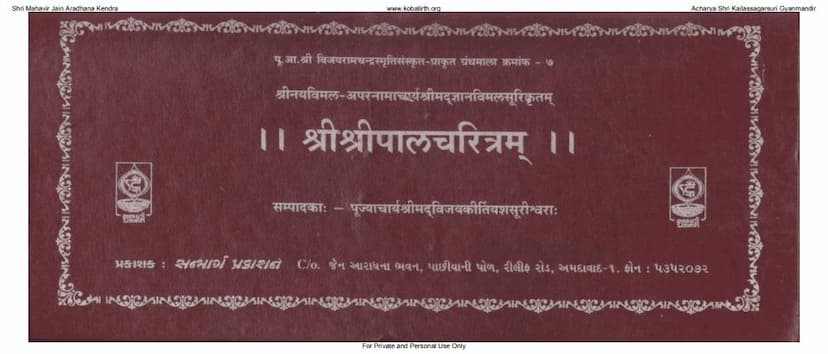Shripal Charitram
Added to library: September 2, 2025

Summary
Here is a comprehensive summary of the Jain text "Shripal Charitram" by Kirtiyashsuri, based on the provided pages:
Book Title: Shripal Charitram (श्रीपालचरितम्) Author: Kirtiyashsuri (कीर्तियशसूरि) Publisher: Sanmarg Prakashan (सन्मार्ग प्रकाशन)
Overall Summary:
The "Shripal Charitram" is a Jain narrative detailing the life and spiritual journey of Shripal, a prince whose life is marked by trials and ultimately redemption through devotion to Jain principles, particularly the veneration of the Siddha Chakra. The text highlights the importance of good conduct, faith, and the consequences of one's actions (karma). It begins with the spiritual teachings of Lord Mahavir through his chief disciple Gautam Swami and then narrates the story of Shripal, his hardships, his eventual association with the Siddha Chakra, and the subsequent transformation and attainment of happiness and spiritual merit.
Key Events and Teachings:
-
Introduction and Spiritual Discourse: The text opens with a prayer to the Arhats and a brief mention of the glory of the Siddha Chakra. Gautam Swami, a disciple of Lord Mahavir, delivers a sermon on the importance of human birth, the renunciation of worldly pleasures and vices, and the fourfold path of dharma: charity, ethical conduct (shila), austerity (tapa), and spiritual contemplation (bhava). He emphasizes that without "bhava" (true inner feeling/devotion), actions like charity and austerity are fruitless. The ultimate focus is on meditating on the nine divine essences (Navapada) as the path to spiritual liberation.
-
The Birth and Early Life of Shripal: The narrative introduces King Shrenik of Rajgriha and his family. The story then shifts to the kingdom of Malwa and the city of Ujjaini, ruled by King Prajapal. King Prajapal has two wives, Saubhagyasundari and Rupasundari. Rupasundari, the virtuous wife, has a daughter named Surasundari. Surasundari, despite her exceptional qualities, is married to a leper named Ubarana, due to her previous karma. She endures this hardship with grace and unwavering faith.
-
Shripal's Transformation and Trials: Shripal, initially born as the son of King Simharatha of Shankhpur, faces a tragic fate. His father is killed, and he is forced to flee with his mother, Kamalprabha, to avoid his treacherous uncle Ajitasen. They encounter a group of lepers, and Shripal, through his past karma, contracts the same disease. He is later found by Vidhyadhar King Kanakketu and his daughter Madanamanjusa, who is renowned for her beauty and skill in arts.
-
The Test of Madanamanjusa and Shripal's Return: Madanamanjusa, bound by a vow to marry only someone who can solve her riddles, is intrigued by Shripal, who, with the help of a magical artifact (a jewel in a bracelet) and divine intervention, manages to answer them by proxy through a magical doll. This act reveals Shripal's true noble qualities and his divine connections. King Kanakketu accepts Shripal and marries him to Madanamanjusa.
-
Shripal's Reign and Spiritual Endeavors: Shripal, after overcoming many obstacles, including betrayal by the merchant Dhaval and conflict with King Mahakal, eventually returns to his kingdom. He performs acts of great merit, including the worship of the Siddha Chakra, building temples, and showing compassion to all beings. His virtuous actions and devotion to the principles of Jainism lead to his prosperity and spiritual upliftment.
-
The Power of the Siddha Chakra: The text repeatedly emphasizes the significance of the Siddha Chakra, a sacred diagram representing the nine fundamental principles of Jainism. It is depicted as a source of divine power, capable of overcoming obstacles, curing diseases, and bestowing prosperity. The rituals and meditations associated with the Siddha Chakra are presented as a direct path to spiritual merit and eventual liberation.
-
Karma and Rebirth: The narrative illustrates the Jain concept of karma, where actions in past lives have present consequences. Shripal's suffering from leprosy is a result of past negative karma, while his devotion and virtuous deeds lead to his eventual recovery and a prosperous life. The story also touches upon the cycle of rebirth and the ultimate goal of achieving Moksha (liberation).
-
The Role of Gurus and Devotion: The teachings of gurus, particularly Gautam Swami and later Charana Muni, play a crucial role in guiding Shripal and the characters towards righteousness. The importance of unwavering faith, devotion to the Jinendra (Jain Tirthankaras), and adherence to the teachings of the Tirthankaras are consistently highlighted.
-
The Culmination: Shripal, after a righteous reign and consistent practice of dharma, ultimately achieves spiritual liberation. The text concludes by reiterating the power of the Navapada and the Siddha Chakra in attaining happiness in this life and the ultimate goal of Moksha.
In essence, "Shripal Charitram" is an inspirational Jain tale that reinforces the core tenets of Jain philosophy: the law of karma, the path of dharma through ethical conduct, austerity, and devotion, and the transcendent power of the Siddha Chakra. It serves as a guide for devotees, illustrating how faith and righteous actions can lead to overcoming worldly suffering and achieving spiritual glory.